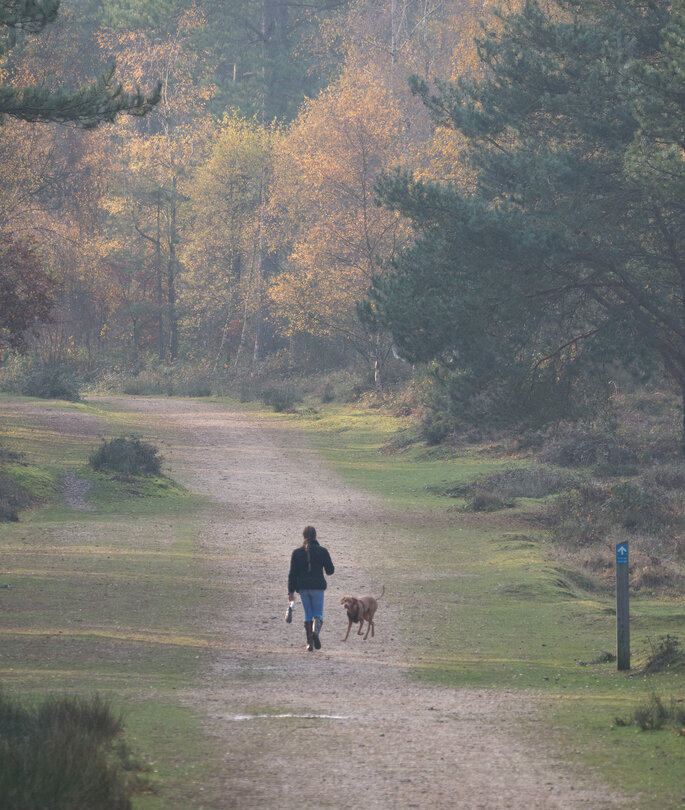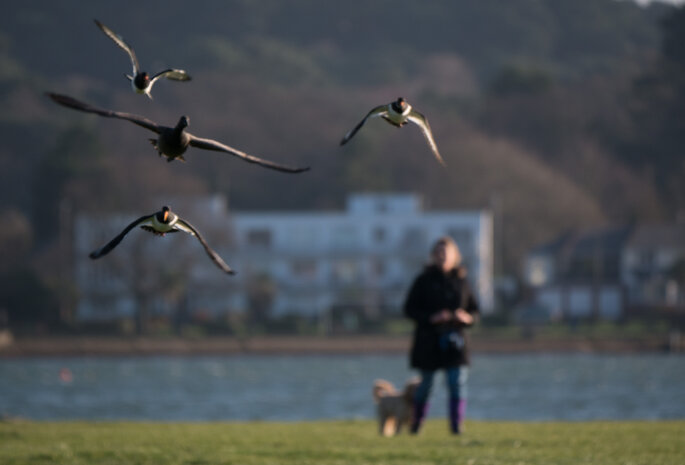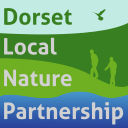Durwyn Liley, Footprint Ecology
Access and nature conservation overlap in a particular way in England. Some of the best countryside sites for recreation are also some of the most important for nature conservation. Some semi-natural habitats have open access and many sites managed for nature conservation have car-parks, trails and a range of opportunities for recreation. By contrast, farmland and much of the wider countryside often has limited access, is less welcoming and is much less pleasant to visit. This is not the case in some other parts of Europe, where recreation on the most important wildlife sites is often highly controlled, and activities such as water sports and dog walking are restricted. In some countries, such as Scotland and across Scandinavia, responsible access is allowed across most land, spreading it more evenly.
Access in nature-rich areas can bring conservation benefits. It is now recognised that “nature connectedness” is linked to pro-conservation behaviour, particularly in children1, and conservation organisations are therefore keen to engage with people and for people to be more aware of their local wildlife. This is very different to the not-too-distant past, when flagship nature reserves such as Arne were only open at limited times and/or a permit had to be obtained in advance, with visitor numbers tightly controlled.

The pandemic has emphasised the importance to our health of spending time in the countryside and local greenspaces. There is now an extensive body of literature highlighting the benefits of being outside in nature for our well-being and, for me personally, the ability to spend time in the natural environment is fundamentally important. During the pandemic outdoor spaces have become the healthy places where meeting others has been allowed, and such places have come to play an important social role. The People and Nature survey results2 indicate two-fifths of the population are spending more time outside than before Covid-19 and around a third of adults have been exercising more in the outdoors.
During lockdown, travel restrictions have meant that local sites have become particularly important and many people have discovered new areas and places close to home. People have also been discovering the nature on their doorsteps that they might previously have overlooked – a friend who lives in urban Bournemouth managed to see 94 bird species between March and December last year, just by standing next to the bins outside his flat and looking skywards!
However, for many people, the wildlife present is incidental to their visit – the majority of visits to the countryside are for dog walking, walking, running and cycling. Few people are drawn specifically by the wildlife – even at our most biodiverse sites. Analysis of national data across the UK suggests that people preferentially select coastal, freshwater and deciduous woodland locations but do not positively select those that are protected sites (SSSIs)3. There is some uncertainty around whether more biodiverse sites provide more well-being benefits. While some researchers have found a correlation between species-richness and psychological benefits4, others suggest that sites perceived to be species-rich are the ones that deliver the most benefit5.

High levels of recreation have impacts, and many of these have been exacerbated during the pandemic. More people means more trampling, erosion, spread of non-native species, fires, dog fouling and disturbance. The devastating fire in Wareham Forest in the summer 2020 is a local example, and has been linked to the use of a disposable barbeque. Looking nationally, sites such as Dartmoor, the Lake District and the Peak District have featured in headlines due to the damage caused by high numbers of visitors and damaging behaviours. Even before the pandemic, there was strong evidence for widespread impacts at a population level for some key species as a result of recreational disturbance, for example Ringed Plovers6, Woodlarks7 and Chough8.
There is clearly a difficult balancing act and no easy solutions. Impacts are usually related to either high visitor levels or particular behaviours. At the moment, it is hard to predict whether the changes brought about by the pandemic in how people use the countryside will persist and how access patterns might change. It is clear that we need plenty of space in the countryside for recreation. In order to ensure access levels are sustainable in the future, there is surely a need for more space for recreation where it will not damage wildlife.

In Dorset, this balancing act is not new. Suitable Alternative Natural Greenspace (SANGs) have been one of the ways in which the impacts from urbanisation and recreation on our heaths have been mitigated. The aim of SANGs is to provide alternative places for recreation, reducing the pressure on the heaths. Anecdotal information suggests that SANGs have been particularly busy during lockdown.
Looking back at the last 13 years or so and at the various SANGs that have been created, I am impressed by the way SANGs have worked and by the role they have recently played during the pandemic. SANGs are essentially managed primarily for access (but can still be important places for nature), meaning that nature reserves management can focus more on conservation and related engagement. I’ve certainly been making use of my local SANG over the last year and am appreciative of the opportunity it has provided for healthy and inspiring time outside.
Sources
1. Hughes, J., Richardson, M. & Lumber, R. Evaluating connection to nature and the relationship with conservation behaviour in children. Journal for Nature Conservation 45, 11–19 (2018).
2. December interim indicators: www.gov.uk/government/statistics/the-people-and-nature-survey-for-england-monthly-interim-indicators-for-december-2020-experimental-statistics
3. Hornigold, K., Lake, I. & Dolman, P. Recreational Use of the Countryside: No Evidence that High Nature Value Enhances a Key Ecosystem Service. PLOS ONE 11, e0165043 (2016).
4. Fuller, R. A., Irvine, K. N., Devine-Wright, P., Warren, P. H. & Gaston, K. J. Psychological benefits of greenspace increase with biodiversity. Biology Letters 3, 390–394 (2007).
5. Dallimer, M. et al. Biodiversity and the Feel-Good Factor: Understanding Associations between Self-Reported Human Well-being and Species Richness. BioScience 62, 47–55 (2012).
6. Liley, D. & Sutherland, W. J. Predicting the population consequences of human disturbance for Ringed Plovers Charadrius hiaticula: a game theory approach. Ibis 149, 82–94 (2007).
7. Mallord, J., Dolman, P., Brown, A. & Sutherland, W. Linking recreational disturbance to population size in a ground-nesting passerine. Journal of Applied Ecology 44, 185–195 (2007).
8. Kerbiriou, C. et al. Tourism in protected areas can threaten wild populations: from individual response to population viability of the chough Pyrrhocorax pyrrhocorax %J Journal of Applied Ecology. Journal of Applied Ecology 46, 657–665 (2009).
